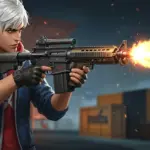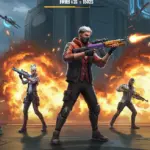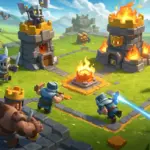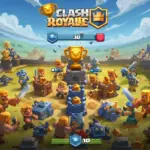Free Fire Vehicle Tactics: Master Driving Skills to Outmaneuver Opponents and Secure Wins
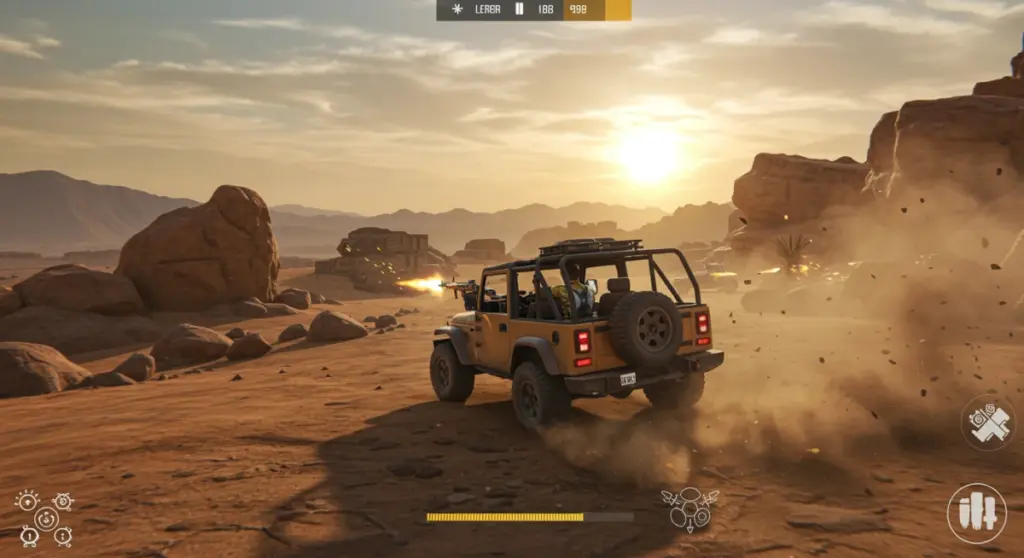
Anúncios
Mastering Free Fire vehicle tactics is crucial for outmaneuvering opponents and securing wins, transforming your gameplay through strategic driving, effective combat from vehicles, and smart evasion techniques on the battlefield.
In the high-octane world of Free Fire, mastering your movement and positioning is paramount. That’s where Free Fire vehicle tactics come into play, offering a critical edge for players looking to dominate the battlefield. Vehicles aren’t just for getting from point A to point B; they are versatile tools for offense, defense, and strategic positioning. Understanding how to effectively use each vehicle, whether for quick rotations, aggressive pushes, or defensive maneuvers, can be the difference between an early exit and a glorious Booyah.
Understanding Vehicle Mechanics and Types in Free Fire
Vehicles in Free Fire are more than just transportation; they are an integral part of your tactical arsenal. Each vehicle type possesses unique characteristics that influence its optimal use in combat and traversal. Knowing these mechanics is the first step towards becoming a vehicle master.
From the zippy sports cars to the tank-like monster trucks, every vehicle has a role. Their speed, durability, and passenger capacity dictate how you should approach different situations. Mastering these nuances allows for dynamic gameplay that keeps opponents guessing and gives your squad a significant advantage.
Speed and Maneuverability
Different vehicles offer varying levels of speed and maneuverability. Sports cars, for instance, are excellent for rapid rotations and escaping the zone quickly, but they offer minimal protection. Jeeps strike a balance between speed and durability, making them versatile for most situations. Understanding these differences is key to selecting the right vehicle for the right moment.
- Sports Car: Ideal for fast rotations, flanking maneuvers, and quick escapes. Low durability.
- Jeep: Balanced speed and durability, good for general movement and some protection.
- Monster Truck: Slow but extremely durable, excellent for cover and breaching obstacles.
- Tuk-Tuk: Slower and less durable, but can be useful in specific urban engagements.
Durability and Protection
The durability of a vehicle directly correlates with the protection it offers. A monster truck can withstand significant damage, acting as a mobile shield, while a sports car will quickly explode under sustained fire. Using vehicles for cover requires an understanding of their health points and how much punishment they can absorb before becoming a liability.
Knowing when to abandon a damaged vehicle or when to use its remaining health as a distraction can be a game-changer. Sometimes, a vehicle exploding near an enemy can even deal critical damage, turning a defensive situation into an offensive opportunity.
In conclusion, a deep understanding of each vehicle’s mechanics, including its speed, maneuverability, and durability, forms the foundation of effective vehicle tactics. This knowledge empowers players to make informed decisions that can significantly impact the outcome of a match.
Strategic Driving for Positional Advantage
Driving in Free Fire isn’t just about holding down the accelerator; it’s a strategic art form. Effective driving can grant you crucial positional advantages, allowing you to control the flow of battle and dictate engagements. This involves more than just speed; it’s about anticipating enemy movements, understanding terrain, and making split-second decisions.
Your driving skills directly influence your ability to outmaneuver opponents. A well-executed turn or a sudden brake can throw off an enemy’s aim, providing precious seconds to retaliate or escape. Strategic driving is about using the environment to your advantage, whether it’s using hills for cover or driving through dense areas to break line of sight.
Mastering Terrain and Obstacles
The Free Fire map is full of varied terrain, from open fields to dense urban environments. Each presents unique challenges and opportunities for vehicle use. Driving over rough terrain in a fast vehicle might slow you down or even cause damage, while a monster truck might traverse it with ease. Understanding how your chosen vehicle interacts with different surfaces is vital.
- Open Fields: High speed is king, but offers little cover. Be wary of snipers.
- Urban Areas: Use buildings for cover, block roads, and create chokepoints.
- Hilly Regions: Utilize inclines for speed boosts and declines for quick escapes.
- Water Bodies: Avoid driving into deep water, as most vehicles are not amphibious.
Flanking and Rotational Strategy
Vehicles are unparalleled for flanking maneuvers and rapid rotations. If the zone is closing in or you need to reposition quickly, a vehicle is your best friend. Use them to get behind enemy lines, surprise unsuspecting squads, or escape dangerous situations. The speed advantage allows you to dictate when and where engagements happen, giving you control over the battlefield.
Effective rotations involve more than just driving in a straight line. Anticipate where enemies might be holding positions and plan your route to avoid direct confrontation unless you intend to engage. Sometimes, a longer, safer route by vehicle is better than a direct, dangerous path on foot.
In essence, strategic driving is about using your vehicle as an extension of your tactical mind. By mastering terrain, understanding vehicle capabilities, and planning your routes, you can consistently gain positional advantages that lead to more secure wins.
Combat From Within and Around Vehicles
Vehicles in Free Fire are not just for movement; they are mobile combat platforms. Engaging in combat from a vehicle or using them strategically in a firefight requires a unique set of skills. This includes knowing when to shoot from the passenger seat, when to use the vehicle as cover, and how to effectively bait enemies.
The ability to transition seamlessly between driving, shooting, and taking cover can turn the tide of any engagement. Players who master these techniques often find themselves outplaying opponents who are solely focused on foot combat.
Shooting from Vehicles
When riding as a passenger, you can shoot from the vehicle, offering a mobile firing platform. This is particularly effective for suppressing enemies, breaking enemy defenses, or providing cover fire for teammates on foot. However, be mindful of your exposure; while you can shoot, you are also vulnerable to incoming fire.
Coordinating with your driver is crucial. A good driver can position the vehicle to give you optimal firing angles while minimizing enemy return fire. Communication is key to successful vehicle-based assaults.
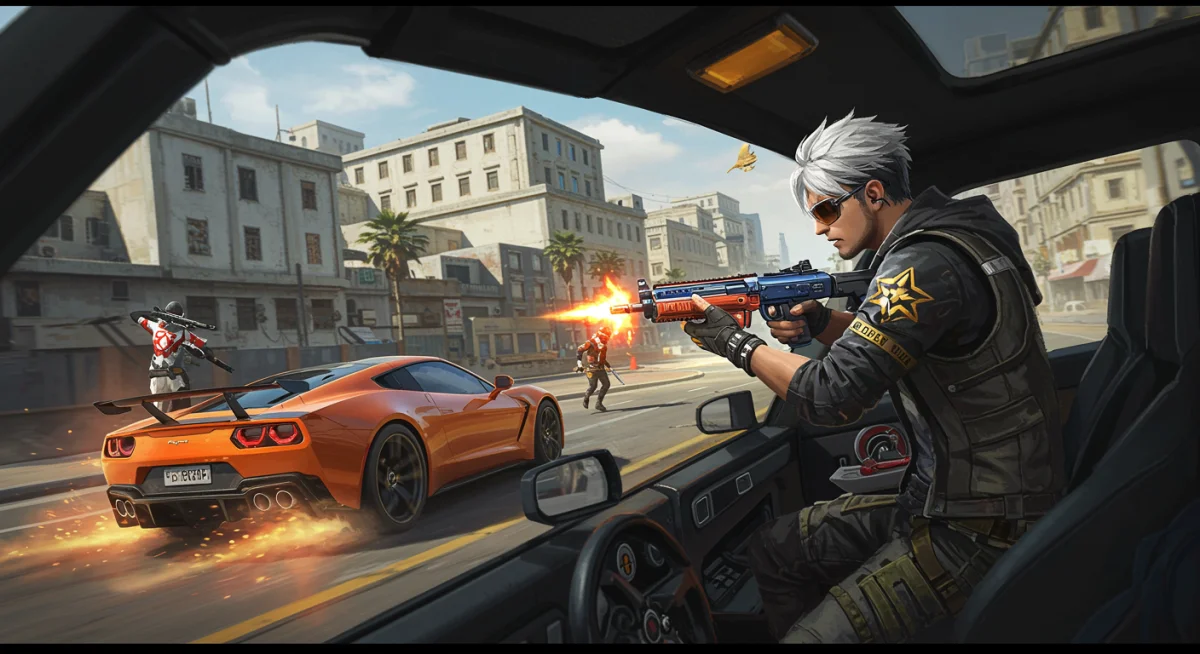
Using Vehicles as Dynamic Cover
A vehicle, especially a durable one, can serve as excellent mobile cover. When caught in an open field, driving a vehicle between you and the enemy can provide vital protection. Once stopped, the vehicle itself becomes a temporary barrier, allowing you to heal, reload, or plan your next move. However, remember that vehicles can explode, so always be ready to disengage if it takes too much damage.
This tactic is particularly effective in the late game when the safe zone shrinks and cover becomes scarce. Positioning a vehicle strategically can force enemies to expose themselves or change their approach, giving you the upper hand.
Whether you’re raining bullets from a moving car or using a jeep to create an impromptu barricade, understanding how to integrate vehicles into your combat strategy is essential. These tactics add another layer of complexity and opportunity to your Free Fire gameplay.
Advanced Evasion and Escape Techniques
Survival in Free Fire often hinges on your ability to escape dangerous situations. Vehicles provide unparalleled opportunities for advanced evasion and escape, allowing you to disengage from losing fights, flee the closing zone, or avoid ambushes. These techniques go beyond simple driving; they involve calculated risks, predictive movements, and quick reactions.
Effective evasion means not just driving away, but doing so in a manner that minimizes damage and maximizes your chances of survival. This often involves using the vehicle’s speed and durability to your advantage, coupled with smart map awareness.
Breaking Line of Sight
When under fire, the quickest way to reduce incoming damage is to break the enemy’s line of sight. Vehicles allow you to do this rapidly. Drive behind buildings, over hills, or into dense foliage to force enemies to reposition or lose track of you. This gives you time to heal, regroup, or even counter-attack.
- Sharp Turns: Quickly change direction to throw off enemy aim.
- Zig-Zag Driving: Make your vehicle a difficult target to hit, especially at long range.
- Using Natural Cover: Drive behind rocks, trees, or structures to block enemy vision.
- Smoke Grenades: Combine vehicle movement with smoke grenades for maximum visual obstruction.
Baiting and Misdirection
Vehicles can be used to bait enemies into unfavorable positions or to create misdirection. For example, driving a vehicle towards a known enemy position and then bailing out at the last second can draw their fire, allowing your teammates to flank. Or, leaving a vehicle in a conspicuous spot can make enemies think you’re still nearby, while you’ve already rotated to a new position.
This requires a good understanding of enemy psychology and map flow. A well-executed bait can turn a disadvantageous situation into a tactical gain, creating confusion and opportunities for your squad.
Ultimately, advanced evasion and escape techniques using vehicles are about controlling the pace of engagement. By knowing when and how to disengage, you can preserve your resources, maintain your health, and live to fight another day, significantly increasing your chances of securing a Booyah.
Vehicle Maintenance and Strategic Destruction
Just like any other piece of equipment, vehicles in Free Fire require strategic consideration regarding their maintenance and, sometimes, their deliberate destruction. A damaged vehicle can be a liability, but a well-timed explosion can be a powerful weapon. Understanding these aspects adds another layer to your vehicle tactics.
Keeping track of a vehicle’s health and knowing when to repair or abandon it is crucial. Similarly, recognizing when blowing up a vehicle can benefit you or hinder your opponents can lead to unexpected victories.
Monitoring Vehicle Health
Vehicles take damage from bullets, crashes, and the zone. Keep an eye on your vehicle’s health bar. If it’s critically low, it’s often safer to abandon it and proceed on foot or find alternative transportation. A vehicle exploding while you’re inside can result in instant elimination or significant damage.
While repair kits for vehicles are not a standard item, sometimes a quick stop at a vending machine or a safe zone can allow for a brief respite to assess the situation and decide if the vehicle is still viable for continued use.
Deliberate Vehicle Destruction
There are times when destroying a vehicle can be a tactical advantage. For instance, if an enemy is using a vehicle for cover, focusing fire on it to make it explode can deal splash damage to them. Similarly, if you’re leaving a vehicle behind and don’t want enemies to use it, destroying it prevents them from gaining a mobility advantage.
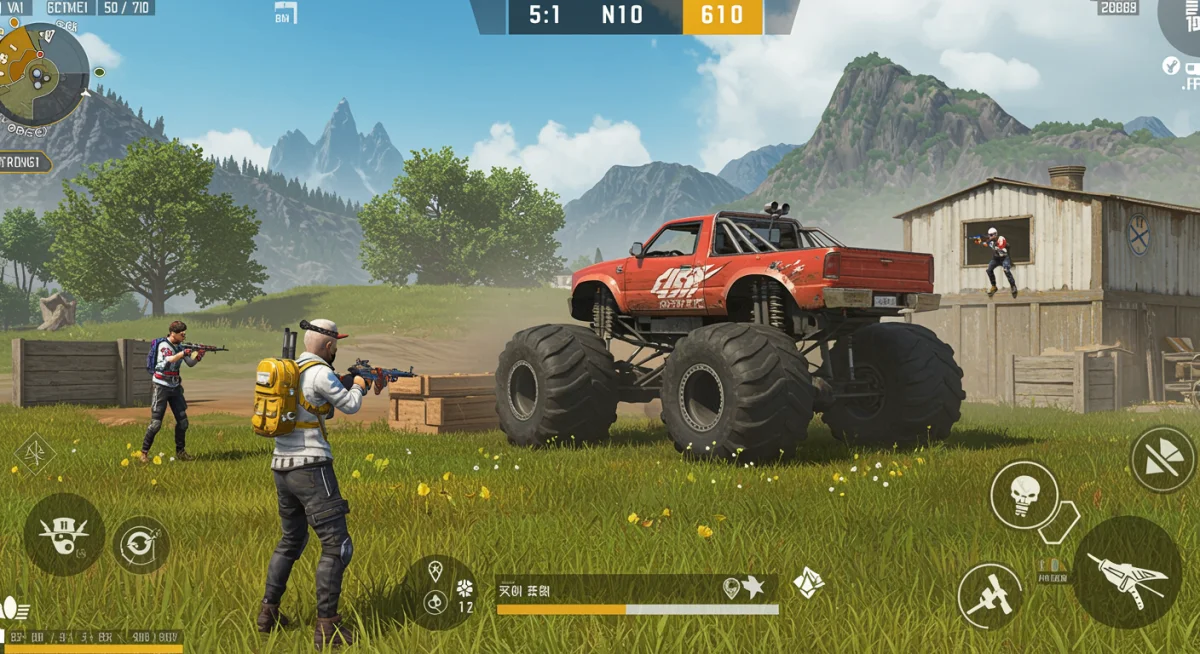
- Explosive Damage: Use vehicles as mobile bombs by shooting them when enemies are close.
- Denial of Resources: Destroy enemy vehicles to limit their mobility and escape routes.
- Blocking Paths: Exploded vehicles can create temporary roadblocks in narrow areas.
- Psychological Warfare: An exploding vehicle can cause panic among enemy squads.
Strategic destruction, whether of your own vehicle or an opponent’s, requires careful timing and assessment of the situation. It’s a high-risk, high-reward tactic that, when executed correctly, can dramatically shift the momentum of a fight in your favor.
Team Coordination with Vehicle Tactics
Free Fire is a team game, and effective vehicle tactics are amplified through strong team coordination. A squad that communicates and utilizes vehicles together can achieve far more than individual players. This involves coordinated pushes, defensive formations, and synchronized rotations that leverage the unique advantages of vehicles.
From designating a dedicated driver to coordinating fire from multiple vehicle positions, teamwork transforms vehicles from simple transport into powerful tactical assets. Communication is the bedrock of successful vehicle-based team play.
Designated Roles and Communication
Assigning roles within a vehicle can streamline combat and movement. One player can be the dedicated driver, focusing on navigation and evasion, while others focus on shooting or spotting enemies. Clear communication about enemy locations, intended routes, and tactical objectives is paramount.
A good driver needs to know when to slow down for accurate shooting, when to speed up for evasion, and where teammates are positioned. Likewise, passengers need to provide constant updates on enemy movements and call out targets.
Coordinated Vehicle Attacks and Defenses
Imagine two vehicles approaching an enemy position from different angles, or using a monster truck to create cover while teammates on foot push forward. These coordinated tactics can overwhelm opponents and create impenetrable defenses. Vehicles can be used to block chokepoints, create firing lanes, or provide mobile cover for pushes.
Practicing these maneuvers with your squad in custom games can significantly improve your team’s synergy. Understanding each other’s playstyles and anticipating movements will make your vehicle tactics seamless and highly effective.
Ultimately, team coordination elevates vehicle tactics from individual plays to a cohesive strategy. By working together, communicating effectively, and assigning roles, your squad can leverage vehicles to dominate the Free Fire battlefield and secure consistent wins.
Mastering the Art of Vehicle Control for Victory
Beyond simply driving, mastering vehicle control involves developing an intuitive understanding of how vehicles handle in various situations. This includes precise steering, effective braking, and knowing when to accelerate or decelerate to maintain control. This mastery isn’t just about speed; it’s about precision and adaptability.
A player with superior vehicle control can navigate tight spaces, execute sudden evasive maneuvers, and position their vehicle exactly where it needs to be, even under intense pressure. This level of control opens up a myriad of tactical possibilities.
Precision Steering and Braking
Learning to make sharp turns without losing control, or braking effectively to stop precisely at a desired point, are fundamental skills. This is especially important in urban environments where obstacles are plentiful and space is limited. Practice makes perfect, and spending time understanding each vehicle’s turning radius and braking distance will pay dividends.
Consider using the handbrake (if available for the specific vehicle) for tighter turns or quick stops. These small mechanical advantages can make a big difference in high-stakes situations.
Adapting to Different Speeds and Terrains
Each vehicle handles differently at varying speeds and on different terrains. A fast car might skid on a dirt road, while a slower, heavier vehicle might struggle to climb steep hills. Adapting your driving style to these conditions is crucial for maintaining control and preventing costly accidents.
- High Speed: Requires gentle steering adjustments; sudden movements can lead to loss of control.
- Low Speed: Allows for more precise maneuvering and navigating complex areas.
- Rough Terrain: Reduce speed to maintain control and prevent vehicle damage.
- Smooth Roads: Utilize full speed for quick rotations and escapes.
Mastering the art of vehicle control is about developing muscle memory and an instinctive feel for each vehicle. This deep understanding allows you to execute complex maneuvers effortlessly, turning your vehicle into a powerful, responsive tool that enhances your overall Free Fire gameplay and significantly boosts your chances of victory.
| Key Aspect | Brief Description |
|---|---|
| Vehicle Types | Understand speed, durability, and passenger capacity for each vehicle. |
| Strategic Driving | Use terrain and speed for positional advantage and flanking maneuvers. |
| Combat Integration | Shoot from vehicles and use them as dynamic cover in engagements. |
| Team Coordination | Synchronize vehicle use with teammates for superior tactics and pushes. |
Frequently Asked Questions About Free Fire Vehicle Tactics
For quick rotations in Free Fire, the Sports Car is generally the best choice due to its high speed. It allows players to cover large distances rapidly, escape the zone, or reposition for flanking maneuvers quickly. However, its low durability means it offers minimal protection, so use it wisely.
Vehicles can be used as effective dynamic cover by positioning them between you and enemy fire. Durable vehicles like the Monster Truck are ideal for this. Remember that vehicles can explode if they take too much damage, so be ready to disengage. Use them to break line of sight or create temporary barriers.
Shooting from a moving vehicle is a viable tactic, especially as a passenger, but it comes with risks. While it provides a mobile firing platform, you are exposed to enemy fire. Coordinate with your driver to ensure optimal positioning for shooting while minimizing your vulnerability. Accuracy can also be challenging while moving.
Effective evasion techniques include using sharp turns and zig-zag driving to make your vehicle a difficult target. Drive behind natural cover like hills or buildings to quickly break the enemy’s line of sight. Combining vehicle movement with smoke grenades can also create excellent visual obstruction for escape or repositioning.
Team coordination is paramount for effective vehicle tactics. Assigning roles (driver, shooters), communicating enemy positions, and coordinating vehicle pushes or defensive formations significantly enhances your squad’s capabilities. A well-coordinated team can use vehicles to flank, provide mobile cover, and overwhelm opponents more effectively.
Conclusion
Mastering Free Fire vehicle tactics is a game-changer for any aspiring champion. By understanding the unique attributes of each vehicle, employing strategic driving techniques, integrating vehicles into your combat approach, and coordinating with your squad, you can consistently outmaneuver opponents and secure those coveted Booyahs. The battlefield is dynamic, and vehicles offer the flexibility and power needed to adapt and dominate. Embrace these strategies, practice your driving skills, and watch your win rate soar as you become a true master of vehicular warfare in Free Fire.
